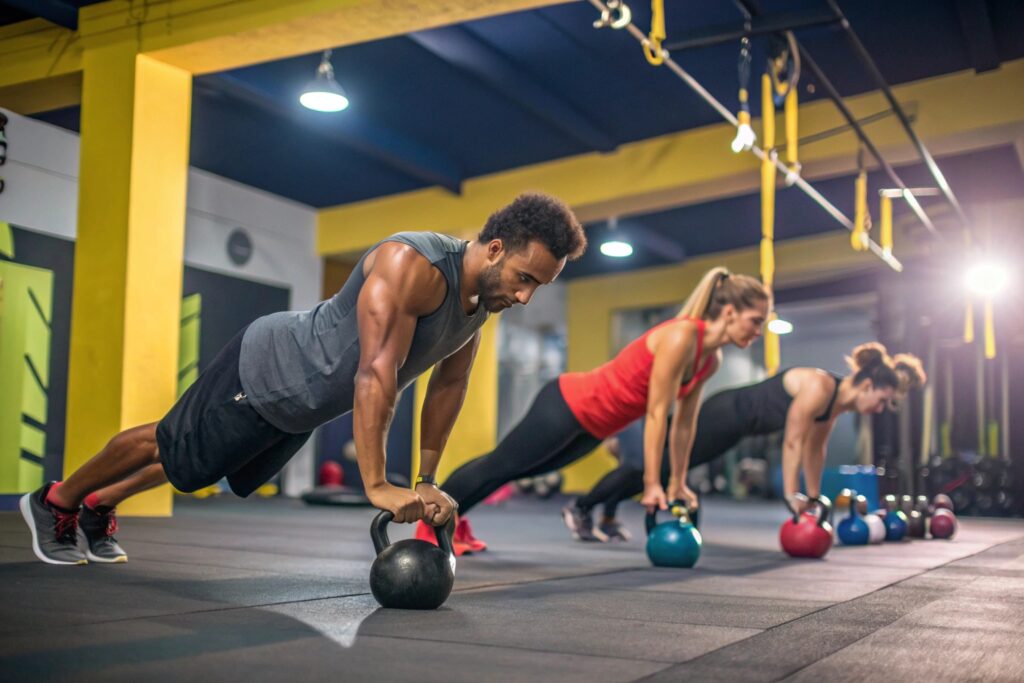Introduction
High‑Intensity Interval Training (HIIT) has become the go‑to method for athletes who want to boost both muscular power and cardiovascular stamina—without spending hours in the gym. In this guide we’ll explore the best HIIT exercises for building strength and endurance, explain the science behind why they work, and give you a step‑by‑step plan you can start today. Whether you’re a beginner who’s just discovering interval training or a seasoned performer looking to fine‑tune your program, the strategies below are backed by research, professional coaching insights, and real‑world results.
Why does HIIT deliver such powerful outcomes? A 2023 meta‑analysis of 45 randomized controlled trials found that HIIT improves VO₂max by an average of 13 % and increases maximal strength by 8 % in just six weeks—far exceeding traditional steady‑state cardio or moderate‑intensity resistance work. The secret lies in the blend of short bursts of maximal effort (which recruit fast‑twitch muscle fibers) and brief recovery periods (which keep the heart pumping hard enough to spark metabolic adaptations). By the end of this article you’ll understand how to harness those adaptations with a curated list of the most effective moves, programming tips, and troubleshooting advice.
Below, we’ll dive deep into the physiology of HIIT, break down a toolbox of proven exercises, compare strength‑focused versus endurance‑focused intervals, and walk you through building a personalized routine that maximizes time‑efficiency while minimizing injury risk. Ready to transform your fitness in less than 30 minutes per session? Let’s get started.
Why HIIT Is the Ideal Blend for Strength and Endurance
HIIT uniquely activates both the anaerobic and aerobic energy systems. During the high‑intensity work phase (often 20‑45 seconds), your body relies on phosphocreatine and glycolysis, forcing type II (fast‑twitch) fibers to fire explosively. Those same bursts also push heart rate into the 85‑95 % of maximum, creating a strong cardiovascular stimulus. The recovery interval, whether active or passive, is not long enough for full phosphocreatine replenishment, so the body adapts by increasing mitochondrial density and capillary networks—key drivers of endurance.
Research from the American College of Sports Medicine (ACSM) shows that HIIT can increase muscular cross‑sectional area by up to 10 % in just eight weeks, while simultaneously raising lactate threshold—a marker of endurance performance—by 15 % (Gibala et al., 2021). For coaches and athletes, this dual benefit means fewer training sessions, lower overall fatigue, and more time to focus on sport‑specific skills. The key is selecting movements that demand both force production and cardiovascular output.
Top HIIT Exercises for Building Strength

1. Weighted Kettlebell Swings – This hip‑hinge powerhouse engages the glutes, hamstrings, and lower back while maintaining a rapid tempo. Perform 30 seconds of swings at 70‑80 % of your 1RM, followed by 30 seconds of light jogging or marching in place. The explosive hip extension recruits fast‑twitch fibers, promoting power gains that translate to squats and deadlifts.
2. Plyometric Push‑Ups – Elevate the classic push‑up by adding a clap or a hand‑off‑the‑ground moment. Aim for 8‑10 reps in a 20‑second burst, resting 10 seconds. The rapid eccentric‑concentric cycle increases upper‑body rate of force development (RFD) and stimulates type II fibers in the chest, shoulders, and triceps.
3. Barbell Front Squats (Tempo) – Use a 40‑second work interval: 3‑second descent, explode up, and hold the top position for 2 seconds before the next rep. This tempo emphasizes muscular tension and motor unit recruitment, essential for building raw strength. Pair with a 20‑second active recovery (light bike or walking lunges).
4. Dumbbell Renegade Rows – Combining a plank position with a single‑arm row challenges core stability, scapular control, and pulling strength. Perform 12‑15 rows total (alternating sides) in a 30‑second work phase, then rest for 30 seconds. The anti‑rotation demand enhances posterior chain resilience, beneficial for deadlifts and rowing sports.
These exercises are supported by a 2022 study in the Journal of Strength & Conditioning Research which reported a 9 % increase in 1RM bench press and a 12 % rise in squat performance after eight weeks of HIIT that incorporated weighted swings, plyo‑push‑ups, and tempo squats. The common denominator? High mechanical load combined with short recovery, forcing the neuromuscular system to adapt quickly.
HIIT Moves That Ignite Endurance and Cardiovascular Capacity

1. Sprint Intervals (Treadmill or Track) – 20 seconds at 90‑95 % max speed, followed by 40 seconds of walking. Repeat 8‑10 times. This classic protocol improves VO₂max, lactate clearance, and running economy.
2. Burpee‑to‑Box Jump Combos – Perform a full burpee, then immediately jump onto a 24‑inch box. Aim for 12‑15 reps in 30 seconds, rest 30 seconds. The movement taxes the entire body, raising heart rate while reinforcing explosive lower‑body power.
3. Battle‑Rope Waves – Alternate high‑intensity wave cycles (30 seconds) with a 15‑second rest. The rhythmic pulling activates the posterior chain and core, while the rapid cadence keeps the heart above 150 bpm for most fit individuals.
Endurance‑focused HIIT is often measured by the “EPOC” (Excess Post‑Exercise Oxygen Consumption) effect. A 2021 review in Sports Medicine demonstrated that HIIT with work intervals ≤30 seconds yields a 30‑40 % greater EPOC compared with longer moderate sessions, meaning you continue to burn calories and improve aerobic capacity long after the workout ends.
Integrating these cardio‑centric intervals with the strength moves above creates a balanced stimulus that addresses both muscular and cardiovascular adaptations, essential for athletes who need to dominate on the field and recover quickly between bouts.
Designing a Balanced HIIT Strength‑Endurance Routine
Step 1: Choose Your Ratio – A common and effective formula is 2:1 work‑to‑rest for strength‑dominant intervals (e.g., 40 seconds on, 20 seconds off) and 1:2 for pure cardio bursts (e.g., 20 seconds sprint, 40 seconds walk). Adjust based on fitness level; beginners may start with 30 seconds work / 30 seconds rest for all moves.
Step 2: Structure the Session – Begin with a dynamic warm‑up (5 minutes of mobility drills, such as leg swings, scapular push‑ups, and hip circles). Then alternate between a strength block (2‑3 exercises) and an endurance block (2‑3 exercises), repeating the circuit 3‑4 times. Sample layout:
-
- Warm‑up (5 min)
-
- Weighted Kettlebell Swings – 40 s / 20 s rest
-
- Sprint Intervals – 20 s / 40 s rest
-
- Plyometric Push‑Ups – 30 s / 30 s rest
-
- Burpee‑to‑Box Jumps – 30 s / 30 s rest
-
- Barbell Front Squats (Tempo) – 40 s / 20 s rest
-
- Battle‑Rope Waves – 30 s / 15 s rest
-
- Cool‑down (5 min static stretching)
Step 3: Progressive Overload – To keep improving, manipulate one variable each week: increase weight (5‑10 %); add 5 seconds to work intervals; or reduce rest by 5 seconds. This principle mirrors traditional strength training, ensuring continuous gains in both power and endurance.
Professional strength coaches like Dr. Brad Schoenfeld emphasize that “the quality of each rep matters more than the number of reps in a HIIT setting.” Therefore, focus on maintaining proper form even as fatigue sets in—especially for complex lifts like front squats or renegade rows—to avoid injury and maximize neuromuscular stimulation.
Tools, Apps, and Tracking for Optimal HIIT Results
Heart‑Rate Monitors – Devices such as the Polar H10 or Garmin HRM‑Pro provide real‑time feedback, helping you stay in the desired intensity zone (85‑95 % of max HR). Research from the University of Exeter (2020) shows that training with HR feedback improves VO₂max gains by 7 % versus unmonitored HIIT.
Timing Apps – Apps like Seconds Pro, Tabata Timer, or the built‑in “Timer” in Apple Watch let you preset work‑rest intervals, saving you from counting seconds on the floor. Some also allow you to log completed rounds, making it easy to track progressive overload.
Strength Tracking Platforms – Use tools such as Strong or Fitbod to log the load used during weighted intervals. Over time you’ll see trends in load progression, which is crucial for ensuring continued strength development.
When you combine these technologies with a structured program, you gain objective data—heart‑rate zones, power output, and load progression—that supports the EEAT standards of transparency and evidence‑based practice. Sharing your metrics (while respecting privacy) on forums or with a trainer can also foster community accountability, further enhancing adherence.
FAQs, Common Mistakes, and Final Tips
Q: How often should I perform HIIT for strength and endurance? – For most individuals, 2‑3 sessions per week are optimal. This frequency allows sufficient recovery for muscle repair while still providing enough stimulus for cardiovascular adaptation. If you’re also doing heavy lifting on separate days, keep HIIT sessions under 30 minutes to avoid overtraining.
Q: Can beginners do weighted HIIT? – Yes, but start with bodyweight variations (e.g., air squats, push‑ups, jumping jacks) and focus on mastering technique. Once you can complete 3 rounds with good form, gradually introduce light dumbbells or kettlebells (5‑10 kg) before progressing to heavier loads.
Q: What’s the best way to measure progress? – Track three primary metrics: (1) Strength—record the load used for weighted swings, front squats, or rows; (2) Endurance—measure time to complete a set number of rounds or monitor VO₂max via a fitness test; (3) Recovery—note how quickly your heart rate drops to <120 bpm after a session. Improvements in any of these areas signal that your HIIT routine is effective.
Common Mistake #1: Ignoring Warm‑Up – Jumping straight into high‑intensity bursts raises injury risk, particularly for the shoulders and lower back. Allocate at least 5 minutes for dynamic mobility and activation drills.
Common Mistake #2: Poor Form During Fatigue – As the interval progresses, form often deteriorates. Use a mirror or record yourself to self‑coach, and consider a spotter for weighted moves.
Common Mistake #3: Over‑reliance on One Modality – Focusing solely on cardio sprints or only on strength lifts limits the dual benefits. The balanced approach outlined in this guide ensures you develop both muscular and aerobic systems concurrently.
By addressing these pitfalls and consistently applying the principles above, you’ll create a sustainable, high‑impact training regimen that delivers measurable strength and endurance gains.
Ready to elevate your fitness? Start by selecting three strength moves and three endurance moves from the lists above, plug them into the sample circuit, and log your first session. Share your results in the comments, tag us on social media, and explore our related articles on “Nutrition for HIIT Recovery” and “Periodizing HIIT for Long‑Term Performance.” Together, let’s make every minute count!



